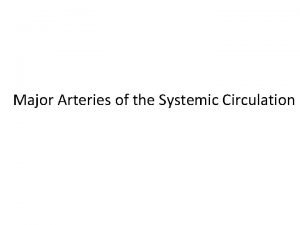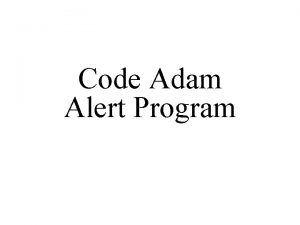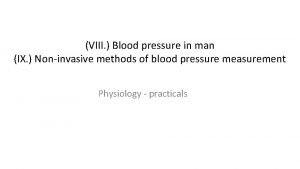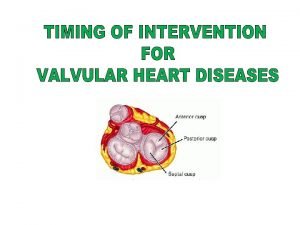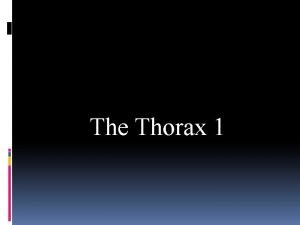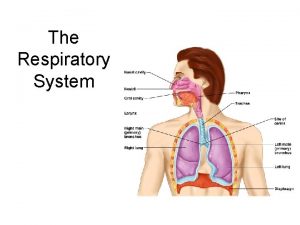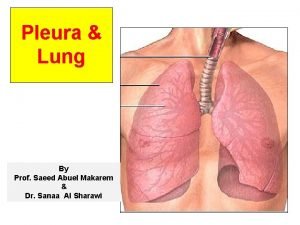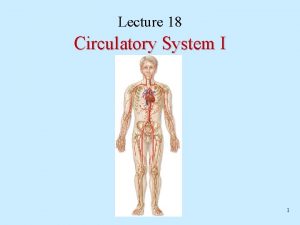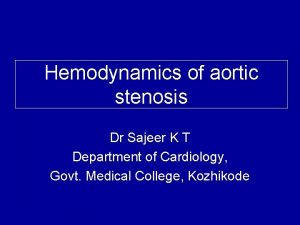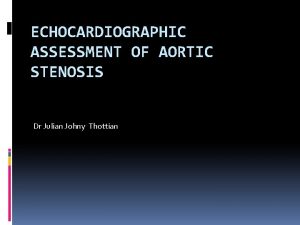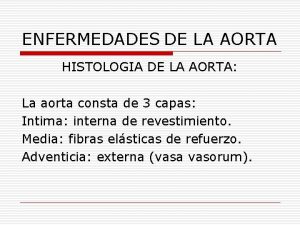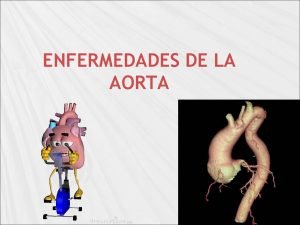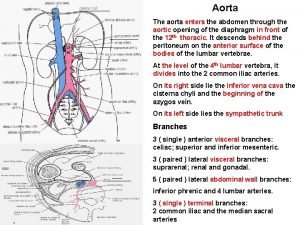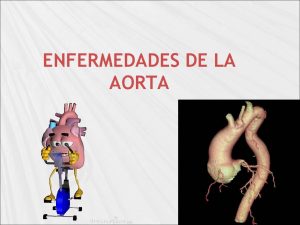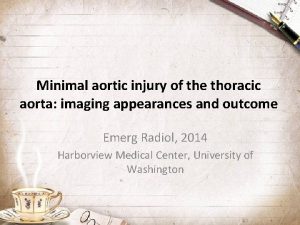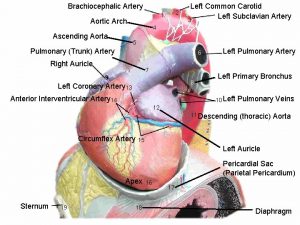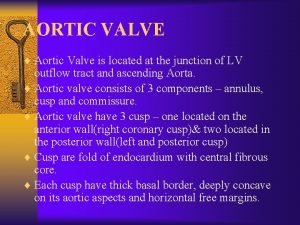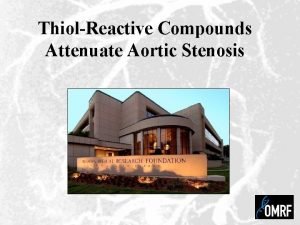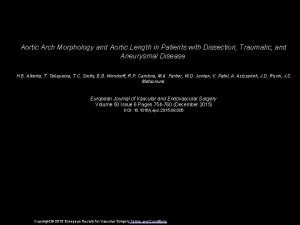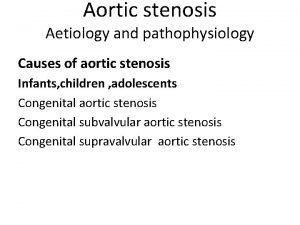Aorta Alert Code Aorta Aortic Center Committee Stony






















- Slides: 22

Aorta Alert & Code Aorta Aortic Center Committee Stony Brook Medicine Developed by Aortic Center Committee 3/2016 Reviewed by KG/cm 3/2016

Objectives The learner will be able to: • Recognize the importance of early identification of signs and symptoms of an acute aortic dissection or ruptured aneurysm • Identify the difference between Aorta Alert and Code Aorta • Explain the role of each of the members of the healthcare team when a patient presents with a suspected or actual ruptured aneurysm, or symptomatic thoracic or abdominal dissection • Identify at least two treatment strategies for the management of patients with acute aortic dissection or aneurysm

Why is Acute Aortic Aneurysm Syndromes a serious healthcare issue? • Ruptured aortic aneurysms are one of the most fatal surgical emergencies with an overall mortality rate of 75%-90% • Many patients are misdiagnosed because of the different anatomical locations of the rupture. Approximately 15, 000 people die each year from a ruptured abdominal aortic aneurysm (AAA) • This can lead to reduced blood flow to vital organs including the brain, spinal cord, intestine, kidneys and the lower extremities. Patients with acute aortic syndromes often require emergent surgical intervention • The classic triad of pain, hypotension and pulsatile abdominal mass due to rupture into the retroperitoneum is only seen in 25 -50% of patients Goal: Deliver the highest quality of care, thus reducing complications arising from this fatal condition

What is an Aorta Alert? Aorta ALERT – An alert activated by or under the direction of an Emergency Medicine Physician for the purpose of rapidly assembling key team members for the prompt diagnosis of a patient with suspected impending aortic catastrophe Aortic Catastrophe: suspected or actual ruptured aneurysm, or symptomatic thoracic or abdominal dissection Note: If patients are transferred from outside institutions with a diagnosis of an type of aortic catastrophe then activate Code Aorta instead of Aorta Alert

Goals of Aorta Alert • Minimize time from ED presentation to diagnosis and treatment • Alert the Aorta Alert Team to confirm the diagnosis and initiate treatment

Criteria to Activate an Aorta Alert includes but not limited to: • • Sudden onset of severe sharp or tearing back, chest, shoulder or abdominal pain • Abrupt in onset and/or severe in intensity • Ripping, tearing, sharp or stabbing quality • Unexplained Syncope Pulsatile Abdominal Mass Clinical Presentation of multiple simultaneous perfusion deficit or chest pain with other perfusion deficit: CNS, mesenteric (presents with acute abdominal pain), myocardial or limb ischemia Physical Exam Evidence of perfusion deficit: pulse deficit, upper extremity blood pressure differential (different pressures on right arm vs. left arm), focal neurological deficits in conjunction with pain (stroke-like symptoms with chest pain) and /or new murmur of aortic insufficiency end organ deficits Presence of high risk conditions: Marfan syndrome, connective tissue disease, family history of aortic disease, known aortic valve disease, recent aortic manipulation, known aortic aneurysm, prior Endovascular Aneurysm Repair (EVAR) Unexplained or refractory hypotension Point of Care Ultrasound showing sequelae of Aortic Catastrophe: aneurysmal dilation, periaortic hematoma, dissection flap, pericardial effusion, end artery occlusion

Notification Process • Emergency Medicine physician responsible to activate the Aorta Alert • Dial # 0 - tell operator to activate the aorta alert • Tell operator to type in the pager: “AORTA ALERT”, Floor/Room # and call back number • Members on pager notification list: – CT Technologist pager – who notifies Radiology Attending Physician for STAT read of imaging – Vascular Surgery Fellow- who notifies vascular/CT Attending Physician – General Surgery Resident • Pager notification only, note: NO announcement is made overhead

Aorta Alert Response Process • Initiate the Aorta Alert Power Plan • ED staff transfers patient STAT to CT scan as soon as patient is stabilized • Vascular/CT Attending Physician on call and ED Attending Physician maintain close contact regarding patient status. • ED Attending Physician reviews images with Radiology Attending and confers with Vascular/CT Attending to determine plan • If operative management is indicated, Code Aorta is activated

Must call Vascular Fellow with results of imaging

What is Code Aorta? • Hospital wide protocol for a clinical response to an impending or actual ruptured/dissected thoracic or abdominal aortic aneurysm • Adult protocol to be initiated for patients 18 years of age or older • This may occur while patient is: – En route from an outside facility (confirmed diagnosis on Cat scan with angiography) (CTA) or Ultrasound – In the Emergency Department: Converted from a AORTA ALERT to Code Aorta – Hospitalized as an inpatient with associated symptoms • The Vascular Fellow/ In-house Surgical Chief is paged to respond to the patient’s bedside. The Vascular Surgery Fellow immediately contacts the Cardiothoracic and/or Vascular Surgery Attending Physician to discuss the case and respond to the bedside • Goal: Expedite the patient to the operating room for a resuscitative procedure Code Aorta is only for surgical candidates who are going immediately to the operating under the direction of the vascular/CT Surgery Attending

Once Code Aorta is called: • Anesthesia coordinator begins preparations for accommodating the patient for a repair procedure. • Communication between anesthesiologist and Surgeon is crucial for management of patient prior to going into the operating room

Code Aorta Members who can Activate a Code Aorta: • Emergency Department Attending AFTER determination has been made by the Surgical Attending • Vascular Fellow • Vascular Attending • Cardiothoracic Attending

Code Aorta Response Team A designated team of qualified staff to provide emergency care to the adult patient who presents with either an acute aortic dissection or symptomatic/ruptured aortic aneurysm • • • Vascular Surgery, Vascular Fellow Cardiothoracic & Anesthesia Attending Physicians General Surgery Resident Anesthesia Resident ADN

Guidelines Code Aorta

BACK UP CODE AORTA • A secondary code utilized to ensure rapid assessment of a patient in the event that there is no immediate response to an initial Code AORTA • If a member of the surgical team (Vascular Fellow, Vascular or Cardiothoracic Surgery Attending) does not call back the ED Attending within approximately 5 minutes, a “BACK UP CODE AORTA” is called by the ED Attending. For a “BACK UP CODE AORTA”, all CT/Vascular Attending Physicians are paged for immediate response

Key Points Process for Patients En Route from an Outside Facility • EMS calls directly to the CT/Vascular Attending according to the EMS transfer Protocols • EM Attendings are not to accept Aortic Catastrophe Cases, but rather decision should go through Vascular or Cardiothoracic Attending • Code activation by ED attending after determination by the CT/Vascular Attending/Fellow • ED Physician or Vascular Attending responsible for uploading from Life Image to SBM PACS. for review while pt enroute: MUST place order in Cerner for “ CT-Body Outside Image Consult”. *Images will not be transferred until order is placed. • Initiate the Code Aorta Power Plan • Initiate Management Guidelines and Communicate with Anesthesia • Transfer patient to OR for repair expeditiously

“Code Aorta” Power Plan “Aorta Alert” Power Plan In Production Same orders as “Code Aorta” Power plan EXCEPT Does not include the Massive Transfusion Protocol

Role of nurse if Aortic Catastrophe suspected in a hospitalized patients: • Unit staff activates Code Rapid Response or Code Blue based on patients presenting symptoms and/or change in condition • Gives SBAR report including patient’s history and presenting symptoms • Response team notifies Vascular Fellow/CT/Vascular Attending who then activates Code Aorta

High suspicion for Ruptured/Dissected or Symptomatic TAA or AAA Key Points • High suspicion, not confirmed: Activate the Aorta Alert Sudden onset severe chest, shoulder or abdominal pain Hemodynamic instability Family History of Aortic aneurysm History of Endovascular Aortic Repair with abdominal or chest pain Presence of pulsatile abdominal mass Current or past smoking history • Code Aorta activation is only for a confirmed diagnosis and if a surgical candidate who is going to the operating room immediately • ED attending can activate only after determination by the CT/Vascular Attending/Fellow • ED can activate the BACK UP Code AORTA in the event of no response to the initial Code AORTA • Usually willing to tolerate permissive hypotension (Systolic BP< 80 mm. Hg and/or not mentating) with conservative fluid resuscitation in cases of aortic catastrophe (see power plan) • Must use the appropriate Power Plans: Aorta Alert or Code Aorta • Inpatient: Staff determines Code Rapid Response or Code Blue based on patient’s status. Response team notifies Vascular Fellow/CT/Vascular Attending who then activates Code Aorta

KEY Points for Imaging Studies • CTA protocol-OK to proceed without labs. Provide premedication if mild or moderate allergy to contrast (see Power Plan) • Do not need to wait for premedication in event of contrast allergy • If DOCUMENTED severe life threatening IV contrast allergy then order a non-contrast CT (see Power Plan) • If outside studies suggest possible ascending aortic or root dissection then order: “Gated Aorta Chest with CTA abd. /pelvis” (see Power Plan)

References • • • Brahmbhatt R, Gander J, Duwayri Y, Rajani RR, Veeraswamy R, Salam A, Dodson TF, Arya S. Improved trends in patient survival and decreased major complications after emergency ruptured abdominal aortic aneurysm repair. J Vasc Surg. 2016; 63: 39 -48. Afifi RO, Sandhu HK, Leake SS, Rice RD, Azizzadeh A, Charlton-Ouw KM, Nguyen TC, Miller CC 3 rd, Estrera AL, Safi HJ. Determinants of Operative Mortality in Patients With Ruptured Acute Type A Aortic Dissection. Ann Thorac Surg. 2016; 101: 6471. Rose J, Evans C, Barleben A, Bandyk D, Wilson SE, Chang DC, Lane J. Comparative safety of endovascular aortic aneurysm repair over open repair using patient safety indicators during adoption. JAMA Surg. 2014; 149: 926 -32. Grau JB, Kuschner CE, Ferrari G, Wilson SR, Brizzio ME, Zapolanski A, Yallowitz J, Shaw RE. Effects of a protocol-based management of type A aortic dissections. J Surg Res. ; 2015: 197: 265 -9. Harris DG, Rabin J, Kufera JA, Taylor BS, Sarkar R, O'Connor JV, Scalea TM, Crawford RS. A new aortic injury score predicts early rupture more accurately than clinical assessment. J Vasc Surg. 2015; 61: 332 -8. Rabin J, Du. Bose J, Sliker CW, O'Connor JV, Scalea TM, Griffith BP. Parameters for successful nonoperative management of traumatic aortic injury. J Thorac Cardiovasc Surg. 2014; 147: 143 -9. Capoccia L, Riambau V. Current evidence for thoracic aorta type B dissection management. Vascular. 2014; 22: 439 -47. Sakran JV, Holena D, Reilly PM, Dickinson ET. Team effort: collaboration makes survival possible for thoracic injury patient. JEMS. 2012; 37: 28 -31. Pongratz J, Ockert S, Reeps C, Eckstein HH. Traumatic rupture of the aorta: origin, diagnosis, and therapy of a life-threatening aortic injury. Unfallchirurg. 2011; 114: 1105 -12. Stony Brook Medicine Administrative Policy ; PC 0165 Code Aorta ( Ruptured or Symptomatic Thoracic/Abdominal Aortic Aneurysm-Adult) 2016. Powell JT, Hinchliffe RJ. Emerging strategies to treat ruptured abdominal aortic aneurysms. Expert Rev Cardiovasc Ther. 2015; 13: 1411 -8. Mell MW, Wang NE, Morrison DE, Hernandez-Boussard T. Interfacility transfer and mortality for patients with ruptured abdominal aortic aneurysm. J Vasc Surg. 2014; 60: 553 -7.

Post Test • The classic triad of pain, hypotension and pulsatile abdominal mass due to rupture into the retroperitoneum is only seen in 25 -50% of patients. – A)True – B)False • Who is responsible for initiating Aorta Alert? – A) Triage RN – B) Emergency Medicine Physician – C) Vascular Fellow – D) Cardiothoracic Attending • Which statement is true regarding the difference between an Aorta Alert and Code Aorta? – A) No difference – B) Aorta Alert is facilitate rapid diagnosis and management in undifferentiated ED patients and Code Aorta is for patients with a confirmed diagnosis and needs an immediate surgical intervention – C) Aorta Alert is a notification by pager only and Code Aorta is announced overhead – D) B and C are both true • When do you initiate a “BACK UP Code Aorta”? – A)Patient diagnosed with a acute thoracic dissection – B) Patient needs the massive transfusion protocol – C) Patient does not need surgery – D) CT/Vascular Attending and or Vascular Fellow did not respond when the Code Aorta was initiated. • What is the most appropriate Radiology workup of a patient with suspected Aortic Catastrophe and DOCUMENTED severe life threatening IV contrast allergy? – – – A) Proceed immediately with CTA Chest, Abdomen and Pelvis following single dose of IV steroids since benefits of imaging outweigh risks. B) Proceed with Non. Contrast CT of Chest/Abdomen/Pelvis. May need to discuss need for performing contrast enhanced CTA which would require prophylactic intubation prior to scanning C) Contact Vascular attending prior initiating Aorta Alert or CODE Aorta Power plan to determine whether Non. Contrast CT versus CTA with contrast should be performed D) Perform MRI of Chest/Abdomen/Pelvis to avoid risk of life threatening allergy E) Contact On-call attending Radiologist to determine relative risk of performing a Non. Contrast MRI or CTA with contrast in the specific patient under question
 Major arteries of the systemic circulation
Major arteries of the systemic circulation Stony brook alert
Stony brook alert Adam alert
Adam alert Busceral
Busceral Map formula bp
Map formula bp Regurgitatiom
Regurgitatiom Commissurotomy
Commissurotomy Thoacic
Thoacic True vocal cord
True vocal cord Physiological regurgitation
Physiological regurgitation Where is the apex of the lungs located
Where is the apex of the lungs located Aorta branches
Aorta branches Dvi aortic valve
Dvi aortic valve Branches off aortic arch
Branches off aortic arch Hakki formula
Hakki formula Para-aortic lymph node
Para-aortic lymph node Dvi in echo
Dvi in echo Continuity equation echo
Continuity equation echo Mitral regurgitation murmur
Mitral regurgitation murmur Aortic valve dimensionless index
Aortic valve dimensionless index Aortic body
Aortic body Interruption of the aortic arch
Interruption of the aortic arch Chest x ray anatomy
Chest x ray anatomy
